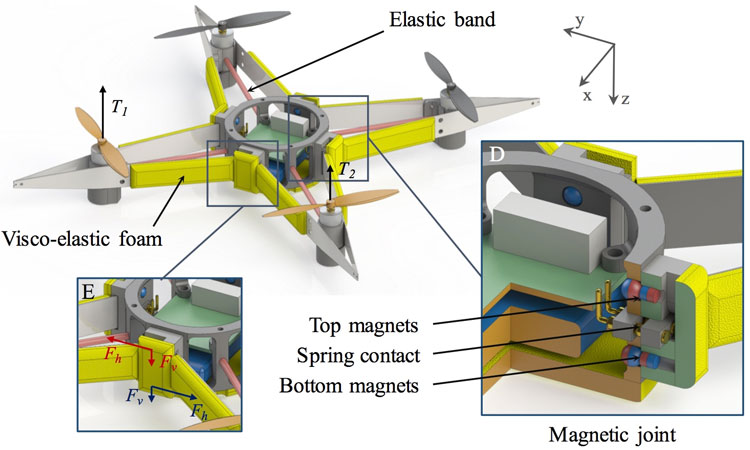When it comes to flying a drone, sooner or later, you’re going to crash it. The question is how exactly you will go about doing this, and how much of the drone will be functional after it’s happened.
Most flying animals somewhat frustratingly don’t have this problem: Birds and insects run into things occasionally (or all the time, for small bugs), and just shrug it off and keep on going, thanks to their biological design, which includes both stiffness and flexibility. Now roboticists at the EPFL, in Lausanne, Switzerland, are relying on these same qualities to design a highly resilient quadrotor that’s impressively difficult to destroy.
There are three primary strategies for designing drones with impact resistance. The first is to just protect the propellers by surrounding them with the frame of the drone or with individual propeller guards. Most commercial drones have something like this. With this level of protection, you’re less likely to injure people, but since the prop protection is rigid, you’re more likely to injure the drone itself if (I mean, when) you crash it.
The second level of impact protection is to design your drone in a way that it can absorb energy from the crash without breaking into pieces. One way of doing that is to decouple the frame of the drone by, say, using flexible, elastic couplers. This gives you a “squishy” drone, which is very effective at handling impacts, but it’s also squishy in-flight, which causes all kinds of structural and stability problems.
The most impressive level of impact protection that we’ve seen in drones is the brute force approach of just surrounding the entire thing with a flexible, rotating cage. Flyability has made a compelling business case for using drones with protective cages, and for some applications, it’s fantastic. You do, however, pay a penalty, since the cage can increase the overall size of the drone by upwards of 60 percent, meaning that it’s safer to run into things, but you’re also much more likely to run into things. The cage adds mass as well, leading to a drone that can’t lift as much or fly as far.
EPFL’s idea is a compromise of sorts: They’ve managed to create a drone with a frame that’s rigid right up until it smashes into something, at which point it turns flexible.
The inspiration for this design came from insect wings. To fly, insects need wings with high stiffness, but flexibility is critical for absorbing shock, and wasps do it with a special joint that allows the entire wing to “reversibly crumple” during a collision, as the EPFL researchers explain:
Wasp wings display dual stiffness, that is the ability to reversibly transition between rigid and soft states, which provides mechanical resilience without impairing flight performances. The wings of wasps contain a flexible resilin joint… This design allows the wing tip to slightly flex during flight (rigid state), but reversibly crumple… during collisions (soft state). If the dual-stiffness behavior is impaired… the rigid wings undergo severe tear during collision. Therefore, this design provides crash resilience by effectively preventing wing overload during collisions without compromising flight capabilities.
The quadcopter has two main parts: the external frame and a central case. They are held together by magnetic joints, each with two magnets and a spring (inset).
The quadrotor that the researchers came up with uses a flexible frame that locks in place around the core of the quadrotor with magnets. When a collision occurs, the frame breaks away from the magnets, absorbing the energy of the collision. Once the energy is dissipated, elastic bands pull the frame back into its original configuration, and the magnets snap together again, and you’re good to go.
The uniqueness of the proposed design lies in the fact that the frame is rigid during flight, but softens during collisions. This allows combination of the advantages of both rigid and soft systems: stability and rapid response to user commands during flight, leading to flight performance equivalent to a drone equipped with a standard rigid frame, and crash resilience like a soft system. The experiments showed a satisfying survivability of the frame of the drone, that withstood roughly 50 collisions with no permanent damage.
The researchers, who are members of EPFL’s Laboratory of Intelligent Systems, suggest that an approach like this could be useful for all kinds of robots, not just drones. Most robots are rigid for various performance reasons (like precision), but the ability to be flexible when necessary without using intrinsically soft materials could could come in handy for grasping, locomotion, or simply as an added safety measure for human-robot interaction tasks.


Comments are closed, but trackbacks and pingbacks are open.